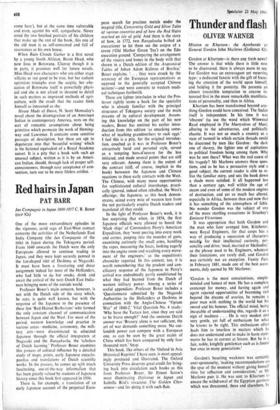Red hairs in Japan
PAT BARR
One of the more extraordinary episodes in the vigorous, acrid saga of East-West contact concerns the activities of the Netherlands East India Company (the Jan Compagnie of the title) in Japan during the Tokugawa period. From 1640 onwards the Dutch were the only Europeans allowed to continue trading in Japan, and they were kept securely penned in the fan-shaped islet of Deshima at Nagasaki. It must have been a frustrating and drear assignment indeed for most of the Hollanders, who had little to do but smoke, drink and await the arrival of the next Dutch East India- man bringing news of the outside world.
Professor Boxer's main concern, however, is not with the Dutch side of the story which, he says, is quite well known, but with the response of the Japanese to the presence of these few 'Red-Haired Barbarians' whb formed the only constant channel of communication between Japan and the West. For most of the period, western knowledge and practice in various areas—medicine, astronomy, the mili- tary arts—were disseminated to educated Japanese through the official interpreters at Nagasaki and the Rangakusha, the 'scholars of Dutch learning.' Professor Boxer examines this process of cultural influence by a detailed study of maps, prints, early Japanese encyclo- paedias and translations of Dutch scientific works. In the process, he comes up with much fascinating, out-of-the-way information that has been greatly valued by students of Japanese history since this book first appeared in 1936.
There is, for example, a translation of an early Japanese account of the perpetual Euro- pean search for precious metals under the magical title, Concerning Gold and Silver Tales of various countries and of how the Red Hairs reached an isle of gold. And there is the story of how, in 1772, two Rangakusha bribed an executioner to let them see the corpse of a crone ('Old Mother Green Tea') on the Edo execution ground. 'Comparing the arrangement of the viscera and bones in the body with that shown in a Dutch edition of the Anatomical Tables of Johan Adam Kulmus of Breslau,'
Boxer explains, . . they were struck by the accuracy of the European representations as opposed to the generally accepted Chinese notions'—and were converts to western medi- cal techniques forthwith.
These are lighter interludes in what the Pro- fessor rightly terms a book for the specialist who is already familiar with the principal structures of Tokugawa society and the main streams of its cultural development. Assum- ing this knowledge on the part of his new readers, Boxer has omitted his earlier intro- duction from this edition 'as smacking some- what of teaching grandmothers to suck eggs.' I feel this is a pity, for the original introduc- tion, couched as it was in Professor Boxer's attractively lucid and personal style, served as a tempting hors-d'oeuvre for the less initiated, and made several points that are still very relevant. Among them is the extent of the contrast (still, of course, implicit in the book) betweeen the Japanese and Chinese reactions to these early contacts with the West. The Chinese, with many more opportunities for sophisticated cultural interchange, practi- cally ignored, indeed often rebuffed, the West's offerings; the Japanese, as this book demon- strates, seized every mite of western lore from the not particularly erudite Dutch traders and translated all they could.
In the light of Professor Boxer's work, it is less surprising that when, in 1854, the first Japanese officials were allowed to board the 'black ships' of Commodore Perry's American Expedition, they 'went peering into every nook and corner, peeping into the muzzles of guns, examining curiously the small arms, handling the ropes, measuring the boats, looking eagerly into the engine room and watching every move- ment of the engineers,' as the expedition's chronicler reported. In this context, too, it is worth remembering that the prudent and con- ciliatory response of the Japanese to Perry's arrival was undoubtedly partly conditioned by what they had learned from the Dutch of western military power. Among a series of useful appendices. Professor Boxer includes a 'Questionnaire submitted by the Nagasaki Authorities to the Hollanders at Deshima in connection with the Anglo-Chinese "Opium War" of 1840-2.' Vital Questioh No. 4 reads: 'Why have the Tartars lost, since they are said to be brave enough?' And the ominous Dutch answer was 'Bravery alone is not sufficient, the art of war demands something more. No out- landish power can compete with. a European one, as can be seen by the great realm of China which has been conquered by only four thousand men.' Snap.
This book, like others of the 'Oxford in Asia Historical Reprints' I have seen, is most appeal- ingly produced and illustrated. The Oxford University Press deserves great credit for bring- ing back into circulation such books as this from Professor Boxer, Sir Ernest Satow's most illuminating Diplomat in Japan and Isabella Bird's vivacious , The Golden Cher- sonese—and for doing it with such flair.






































 Previous page
Previous page